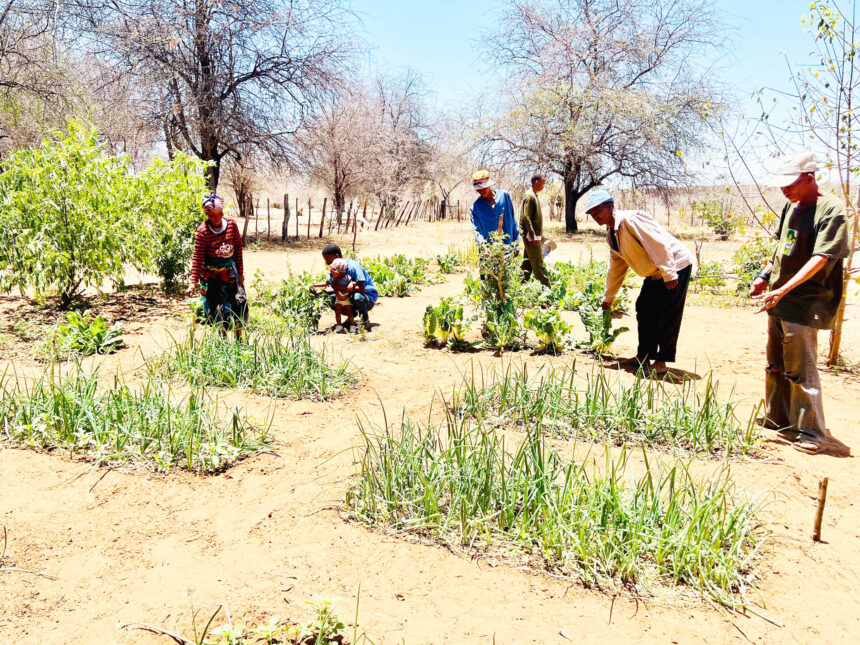TSUMKWE – For decades, the Ju/’hoansi San in the Tsumkwe area have traditionally relied on hunting and gathering for survival.
However, the introduction of trophy hunting operations, which cull wild animals like elephants, alongside the worsening effects of climate change, has dramatically altered their way of life.
Today, some community members have turned to gardening and livestock farming as a means of survival, while others continue to face hardships. Many remain without crops, livestock or traditional sources of food, and they no longer rely on conservancies for support. Instead, they persevere through faith and resilience, awaiting drought relief, which only arrives every six months.
New Era recently visited the Tsumkwe area to observe a day in the life of the Ju/’hoansi San people, 34 years after Namibia’s independence.
The first stop was at !Obaha village, located about 80 kilometres outside Tsumkwe, where the community is gardening and managing their livestock.
In this village, people of all ages are dedicated to ensuring that the garden thrives. Upon arrival, most villagers were seen resting under a tree after completing their morning duties of watering vegetables and fruit trees.
Headman Glaqo /Ang!ao said the village grows spinach, oranges, onions, cabbages, tomatoes and lemons, providing sustenance for all 60 villagers, including children.
This success has been made possible by the Nyae Nyae Conservancy, which ensures access to water. “We are busy here. You arrived a bit late to see our livestock, but we work hard because we understand the importance of nutritious food,” he said proudly. “We are grateful to the organisations which helped us reach this point. Everyone here is fed from the garden, and enjoys milk from the cattle.”
In contrast, !Nhoma village faces severe challenges. The San people here have no benefits and rely solely on drought relief, which, under the marginalised communities’ programme, only reaches them sporadically – sometimes as late as three months. When this crew visited !Nhoma the following day at 07h30, all villagers were gathered around a fire. Unlike other villages, where people gather for breakfast and traditional brews to start the day, the villagers in !Nhoma seemed to be waiting for guidance from Above.
“We used to gather wild food at this time of the year. But due to the lack of rain, we no longer find enough water potatoes and other wild food,” observed an elderly woman. Another villager shared that in the past, the community would gather early each morning to discuss their plans, and decide which direction to head in search of food.
“We used to venture deep into the fields to gather and hunt.
Now, there are trophy hunters who have designated the area. They put up signs saying we cannot go beyond certain boundaries, or we’ll be held responsible”, she lamented.
Maria Dam, one of the villagers, stated that Nhoma does not belong to any conservancy, which means they are excluded from the benefits other villages receive. “Even when trophy hunters kill animals here, they do not share the meat with us because we are not part of a conservancy,” she added.
Dam mentioned that while !Nhoma is near the Na ≠jacna Conservancy, they do not have membership due to language barriers. As Ju/’hoansi speakers, they hope to be included in the Nyae Nyae Conservancy, which understands their language. Without conservancy membership, they endure extreme poverty and struggle to survive. At Ben Se Kamp, villagers practice both gardening and farming, though not all participate. Headman !Kaece Kha//an expressed satisfaction with the villagers’ efforts, noting that those who own livestock tend to them, while others focus on gardening.
“It’s a good thing. Here, those who have food share with those who don’t,” he noted.
The villagers mentioned do not have other forms of development or small businesses such as shebeens, and remain heavily reliant on nature and agriculture for survival. At ≠Otcaoqkxai village, a combination of gardening and livestock management takes place. The headman remarked that the village is peaceful, and the people are committed to agricultural practices. However, conflicts occasionally arise when youth travel to Tsumkwe to drink.
Concerns
Nigel Swartbooi, an administrator at the Nyae Nyae Conservancy, expressed concern over the plight of the !Nhoma San people who are not part of the conservancy. “These communities are missing out on vital support and resources because they are not affiliated with a conservancy,” he said. “Membership offers access to water, sustainable food sources and a connection to conservation efforts which benefit the community. Without these, the people are left struggling with few alternatives.” He added that “the Nyae Nyae Conservancy is open to helping other San communities, especially those who speak Ju/’hoansi, but there needs to be an effort from all parties to facilitate their inclusion. It’s crucial for their survival and well-being that these communities are integrated into conservancy programmes which can offer them the same opportunities for growth and support.”
Swartbooi emphasised that the lack of membership has led to severe hardship for these villagers, who rely on irregular drought relief, and are excluded from any benefits that the conservancy provides, such as trophy hunting revenue, or access to natural resources.
“We continue to advocate for their inclusion, but we need the relevant authorities and organisations to recognise the importance of bringing all San communities into the fold,” he said. The Nyae Nyae Conservancy is at the infancy stage of starting the process of including the villagers in the conservancy because their survival battles are unbearable.


